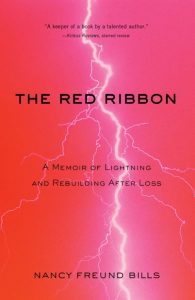Gifts For The Writer
 I met Elizabeth Peavey at the University of Southern Maine’s Stonecoast summer workshop several years ago. As the playwright of “My Mother’s Clothes Are Not My Mother,” she gave her audience something to laugh about. She is a funny lady. As a workshop leader, she made her group of aspiring writers smile and laugh; if I counted one, two, and three, at three, she told a joke. Initially, I felt frustrated. How was I going to do what she did? The answer was that I couldn’t be Elizabeth Peavey.
I met Elizabeth Peavey at the University of Southern Maine’s Stonecoast summer workshop several years ago. As the playwright of “My Mother’s Clothes Are Not My Mother,” she gave her audience something to laugh about. She is a funny lady. As a workshop leader, she made her group of aspiring writers smile and laugh; if I counted one, two, and three, at three, she told a joke. Initially, I felt frustrated. How was I going to do what she did? The answer was that I couldn’t be Elizabeth Peavey.
However, I began to imagine how I could give my readers the equivalent of her jokes. How could I expect my readers to read my memoir, The Red Ribbon, A Memoir About Lightning and Rebuilding After Loss, a book about grief, without some catharsis? What could I share with them that might make them smile or tear up? Maybe they would sigh and ponder some private memory. I did have some humor to offer my readers; I knew my chapter, “Planting Iris,” made them laugh out loud. I had enjoyed writing a piece that explores the absurdities of life and death and responds with hysteria. In other chapters, like “The Oak Box,” I surprise my reader with black humor. And in others, I create humor at my own expense..
While I could not make my readers laugh every few beats, I could keep my promise to admit the reader to my private space. I could share my inner thoughts and prayers. For instance, in Chapter 2, “Off the Dock,” my son, Simon, is wakened in the middle of the night and he walks outdoors in only an Outward Bound T-shirt. The image reminds the reader of Nancy in the Chapter 1, “Arcs and Sparks,” when she is disturbed at three in the morning and fumbles in her overnight bag searching for underpants and a bra. Both images confirm my intention as a writer to strip off defenses and be human.
Sensory-rich passages that appeal to many senses are another kind of gift for the reader. Sensory details can be added after the bones of the story are written. For instance, in “Off the Dock,” I went back and added smells and tastes. Simon is in shock when he learns his father and younger brother have been in an accident. He feels paralyzed but boards a boat to travel to the hospital. “…inside the cramped space below, the combination of dog smell and anxiety combine to make Simon nauseous….He climbs up the ladder tasting tears in his mouth….Part way, Simon walks to the stern prepared to vomit; he retches and can smell a whiff of his supper—onions and beer. But nothing comes up.” Each powerful smell and taste builds on the next until my readers have said, “I felt like I was there.”
Imagery, of course, is not always aversive, and sometimes, many of the words a writer is searching for actually appear in the rough draft and need little tweaking. In “Ode to Tapioca,” I describe the mother of a high school friend making tapioca: “Karen’s mother created a concoction of white pearls and golden foam. My tongue and the roof of my mouth had never tasted, never touched anything so light and white and delicious. No words are round enough or sufficiently both delicate and bold to describe Mrs. Nelson’s tapioca.” This extended image goes on for two paragraphs and leaves the reader hungry.
Another way to give the reader a gift is to foreshadow a future event; the reader has the pleasure of anticipating whatever is promised and the satisfaction of guessing it correctly. For instance, in the Prologue of The Red Ribbon, “The Summer Sky,” I muse about growing up in Montana and my awareness that summers brought dangerous storms. “Almost once a summer, a serious storm arrived; thunder and lightning announced the onslaught of torrential rain, pounding hail.” The storms I describe prepare the reader for the drama of the “lightning accident.”
Another gift is to repeat a powerful image but with a twist. An image in the “Prologue” reoccurs at the end of the book in the “Epilogue.” In the Prologue, we read, “The cruel hail battered our garden, ruining our tomatoes and strawberries, scattering their red flesh onto the dusty pale earth.” But by the end of the book in the Epilogue, we read, “The strawberry crop is in! I choose a quart and set them carefully in my back seat. I am dreaming of strawberry shortcake….” Not only is there a repetition of an image, but the image has been transformed from battered and scattered to safe.
The ultimate gift is for the reader to discover the significance of the title, The Red Ribbon. Hidden in the middle of the book, in “The Myth,” the reader finds, “…instead of a red arrow of lightning or scarlet splatters of blood, I’ll see a red grosgrain ribbon like the marker in a family Bible….I’ll bind our story with love and with courage; I’ll lay a red ribbon on the title page.” What was horrifying has been elevated and mastered through the use of language.
—
Award-winning writer NANCY FREUND BILLS is currently on the faculty of the Osher Lifelong Learning Institute at the University of Southern Maine, OLLI/USM, where she facilitates the fiction writing workshop.
She is also a retired clinical social worker; during her twenty-year-long career, she served both as a psychiatric social worker at Concord Regional Hospital in New Hampshire and Maine Medical Center in Portland, Maine, and as a psychotherapist at Green House Group, a group private practice in Manchester, New Hampshire. “The Myth,” Chapter 19 of The Red Ribbon, received first place in the memoir/personal essay category of the 83rd Annual Writer’s Digest Writing Competition.
Her memoir, fiction, and poetry have been published in Reflections, The Maine Review, The LLI Review, The Goose River Anthology, and in The 83rd Annual Writer’s Digest Writing Competition Collection. A member of the Maine Writers and Publishers Alliance (MWPA), she lives in Cape Elizabeth, Maine, with her two Maine Coon cats. Find her online at nancybills-memoir.com.
 In the summer of 1994, a freak lightning and thunder storm explodes on the southern coast of Maine, killing Nancy Bills’s husband and critically wounding her younger son. She promises her late husband that she will write their family’s story and bind it with a red ribbon of love and courage.
In the summer of 1994, a freak lightning and thunder storm explodes on the southern coast of Maine, killing Nancy Bills’s husband and critically wounding her younger son. She promises her late husband that she will write their family’s story and bind it with a red ribbon of love and courage.
In language alternately tender and gritty, The Red Ribbon documents the aftermath of Bills’s husband’s death. As a wife, she grieves and attempts to rebuild her life; as a mother, she strains to be the parent her young adult sons need. Then, one year later, she is faced with more loss―this time, the father whom she adores. After his death, other deaths, some anticipated and others unpredictable, follow. Meanwhile, the impending death of her aging mother is a particular challenge; Nancy struggles to be a good daughter, and on many visits to Montana, her home state, she tries to mend their painful history.
Insightful, moving, and full of intelligence and humanity, The Red Ribbon is a story of surviving the many and often devastating lightning strikes of life, and a gift of compassion and wisdom for readers who are struggling with their own losses
Category: Contemporary Women Writers, On Writing























